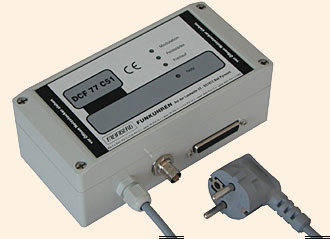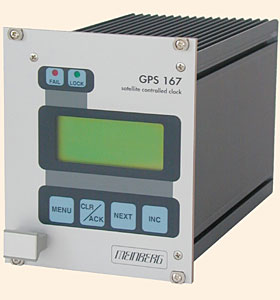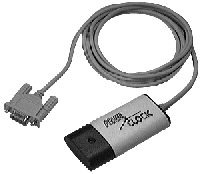1. Name
refclock_generic - multidevice parse driver for generic time radios and GPSDOs.
2. Synopsis
Name: generic Reference ID: DCF | DCFa | DCFp | GPS | MSF Serial Port: /dev/refclock-u; TTY mode according to clock type PPS device: /dev/refclockpps-u; alternate PPS device
3. Warning
Most modes of this driver report only two-digit years, and are thus reliant on the system clock to be near correct before samples will be processed properly. You will not be able to use these modes to run autonomously, nor will they reliably recover from a trashed or zeroed system clock. The only exceptions are the Schweitzer 240x and the Trimble TAIP/TSIP modes.
4. Description
The generic driver supports many different clock types/configurations by plugging type-specific packet-parsing routines into a generic driver framework.
Note that some of these subtypes below are to support equipment that has not been commercially available for a long time, report only 2-digit years (thus being subject to lingering Y2K problems and possible future issues near century boundaries), and may be removed in a future release. See Feature removals for a discussion of this issue.
The actual receiver status is mapped into various synchronization states generally used by receivers. The driver is configured to interpret the time codes of Meinberg DCF77 AM receivers, DCF77 FM receivers, Meinberg GPS16x/17x receivers, Trimble SV6 GPS, ELV DCF7000, Schmid, Wharton 400A and various low-cost receivers.
The reference clock support in NTP contains the necessary configuration tables for those receivers. In addition to supporting several different clock types and multiple devices, the processing of a PPS signal is also provided as a configuration option. The PPS configuration option uses the receiver-generated time stamps for feeding the PPS loopfilter control for much finer clock synchronization.
|
Caution
|
The PPS configuration option is different from the hardware PPS signal, which is also supported (see below), as it controls the way ntpd is synchronized to the reference clock, while the hardware PPS signal controls the way time offsets are determined. |
The use of the PPS option requires receivers with an accuracy of better than 1ms.
5. Timecode variables listed by ntpq(1)
The ntpq program can read and display several clock variables. These hold the following information:
- refclock_format
-
A qualification of the decoded time code format.
- refclock_states
-
The overall running time and the accumulated times for the clock event states.
- refclock_status
-
Lists the currently active receiver flags. Additional feature flags for the receiver are optionally listed in parentheses.
- refclock_time
-
The local time with the offset to UTC (format HHMM).
- timecode
-
The actual time code.
If PPS information is present, additional variables are available:
- refclock_ppsskew
-
The difference between the RS-232-derived timestamp and the PPS timestamp.
- refclock_ppstime
-
The PPS timestamp.
6. Supported Devices
Twenty-five clock types are supported by the GENERIC driver and any number of these clocks may be operational at any one time.
Note: Under NTPsec, you must use the new configuration syntax
(refclock generic subtype N) to declare generic clocks, rather than
the old-style syntax with a magic address, unless the software has
been built with the --enable-classic-mode option in which case only
the old-style syntax will work.
A note on the implementations:
-
These implementations were mainly done without actual access to the hardware, thus not all implementations provide full support. The development was done with the help of many kind souls who had the hardware and kindly lent me their time and patience during the development and debugging cycle. Thus for continued support and quality, direct access to the receivers is a big help. Nevertheless I am not prepared to buy these reference clocks - donations to (kardel@ntp.org) are welcome as long as they work within Europe 8-).
The pictures below have been archived from the vendors' web pages.
Verified implementations are:
-
RAWDCF variants
These variants have been tested for correct decoding with my own homegrown receivers. Interfacing with specific commercial products may involve some fiddling with cables. In particular, commercial RAWDCF receivers have a seemingly unlimited number of ways to draw power from the RS-232 port and to encode the DCF77 datastream. You are mainly on your own here unless I have a sample of the receiver.
-
* Meinberg clocks *
These implementations have been verified by the Meinberg people themselves and I have access to one of these clocks.
-
Schweitzer Engineering Laboratories SEL-240x clocks *
This implementation was provided and verified by SEL and Network Time Foundation has an SEL-2407 in one of its development labs.
-
refclock generic subtype 0
Meinberg PZF5xx receiver family (FM demodulation/TCXO / 50μs)
WarningThis equipment is no longer available for commercial sale, and support may be removed in the future. See: Feature removals -
refclock generic subtype 1
Meinberg PZF5xx receiver family (FM demodulation/OCXO / 50μs)
WarningThis equipment is no longer available for commercial sale, and support may be removed in the future. See: Feature removals

-
refclock generic subtype 2
Meinberg DCF C51 receiver and similar (AM demodulation / 4ms)

This subtype expects the Meinberg standard time string format with 9600/7E2.
Note: subtype 2 must also be used for Meinberg PCI cards under Linux, e.g. the GPS PCI card or the DCF77 PCI card. Please note the Meinberg Linux driver must be installed. That driver emulates a refclock device in order to allow ntpd to access those cards. For details, please refer to the README file that comes with the Meinberg driver package.
-
refclock generic subtype 3
ELV DCF7000 (sloppy AM demodulation / 50ms)
WarningThis equipment is no longer available for commercial sale, and support may be removed in the future. See: Feature removals -
refclock generic subtype 4
Walter Schmid DCF receiver Kit (AM demodulation / 1ms)
WarningThis equipment is no longer available for commercial sale, and support may be removed in the future. See: Feature removals -
refclock generic subtype 5
RAW DCF77 100/200ms pulses (Conrad DCF77 receiver module / 5ms)
-
refclock generic subtype 6
RAW DCF77 100/200ms pulses (TimeBrick DCF77 receiver module / 5ms)
-
refclock generic subtype 7
-
Meinberg GPS16x/GPS17x receivers (GPS / <<1μs) *

This subtype expects either the University of Erlangen time string format or the Meinberg standard time string format at 19200/8N1.
The University of Erlangen format is preferred. Newer Meinberg GPS receivers can be configured to transmit that format; for older devices, a special firmware version may be available.
In this subtype some additional GPS receiver status information is also read. However, this requires a point-to-point connection. Subtype 18 should be used if the device is accessed by a multidrop connection.
Note: subtype 7 must not be used with Meinberg PCI cards; use subtype 2 instead.
-
refclock generic subtype 8

-
refclock generic subtype 9
Trimble SVeeSix GPS receiver TAIP protocol (GPS / <<1μs)
WarningThis equipment is no longer available for commercial sale, and support may be removed in the future. See: Feature removals -
refclock generic subtype 10
Trimble SVeeSix GPS receiver TSIP protocol (GPS / <<1μs) (no kernel support yet)
WarningThis equipment is no longer available for commercial sale, and support may be removed in the future. See: Feature removals 

-
refclock generic subtype 11
Radiocode Clocks Ltd RCC 8000 Intelligent Off-Air Master Clock support
-
refclock generic subtype 12

-
refclock generic subtype 13
Diem’s Computime Radio Clock
-
refclock generic subtype 14
RAWDCF receiver (DTR=high/RTS=low)
-
refclock generic subtype 15
WHARTON 400A Series Clocks with a 404.2 Serial Interface
-
refclock generic subtype 16
RAWDCF receiver (DTR=low/RTS=high)
-
refclock generic subtype 17
VARITEXT Receiver (MSF)
-
Meinberg GPS16x/GPS17x receivers (GPS / <<1μs)
This subtype works without additional data communication (version, GPS status etc.) and thus should be used with multidrop, heterogeneous multiclient operation.
Note: subtype 18 must not be used with Meinberg PCI cards, use subtype 2 instead.
-
refclock generic subtype 19
Gude Analog- und Digitalsystem GmbH 'Expert mouseCLOCK USB v2.0'
-
refclock generic subtype 20
RAWDCF receiver similar to subtype 14, but operating @ 75 baud (DTR=high/RTS=low)
Driving the DCF clocks at 75 baud may help to get them to work with a bunch of common USB serial converters, that do 75 but cannot do 50 baud at all, e.g. those based on Prolific PL2303.
-
refclock generic subtype 21
RAWDCF receiver similar to subtype 16, but operating @ 75 baud (DTR=low/RTS=high)
See comment from subtype 20 clock.
-
refclock generic subtype 22
MEINBERG, subtype 2 but with POWERUP trust
-
refclock generic subtype 23
MEINBERG, subtype 7 but with POWERUP trust
-
refclock generic subtype 24
Actual data formats and setup requirements of the various clocks can be found in NTP GENERIC clock data formats.
7. Operation
The reference clock support software carefully monitors the state transitions of the receiver. All state changes and exceptional events (such as loss of time code transmission) are logged via the syslog facility. Every hour a summary of the accumulated times for the clock states is listed via syslog.
PPS support is only available when the receiver is completely synchronized. The receiver is believed to deliver correct time for an additional period of time after losing synchronization, unless a disruption in time code transmission is detected (possible power loss). The trust period is dependent on the receiver oscillator and thus is a function of clock type.
Raw DCF77 pulses can be fed via a level converter to the RXD pin of an RS-232 serial port (pin 3 of a 25-pin connector or pin 2 of a 9-pin connector). The telegrams are decoded and used for synchronization. DCF77 AM receivers can be bought for as little as $25. The accuracy is dependent on the receiver and is somewhere between 2 ms (expensive) and 10 ms (cheap). Synchronization ceases when reception of the DCF77 signal deteriorates, since no backup oscillator is available as usually found in other reference clock receivers. So it is important to have a good place for the DCF77 antenna. During transmitter shutdowns you are out of luck unless you have other NTP servers with alternate time sources available.
In addition to the PPS loopfilter control, a true PPS hardware signal can be utilized via the PPSAPI interface. PPS pulses are usually fed via a level converter to the DCD pin of an RS-232 serial port (pin 8 of a 25-pin connector or pin 1 of a 9-pin connector), where one edge of the pulse — often the leading edge, but in many cases not — provides the reference. NTPsec uses the edge of the pulse specified by the driver for the particular hardware used. To select PPS support, the subtype parameter is the subtype value as above plus 128. If 128 is not added to the subtype value, PPS will be detected to be available but will not be used.
8. Hardware PPS support
For PPS to be used, add 128 to the subtype parameter.
If the PPS signal is fed in from a device different from the device providing the serial communication (/dev/refclock-\{0..3}), this device is configured as /dev/refclockpps-\{0..3}. This allows the PPS information to be fed in e.g. via the parallel port (if supported by the underlying operation system) and the date/time telegrams to be handled via the serial port.
9. Monitor Data
Clock state statistics are written hourly to the syslog service. Online information can be found by examining the clock variables via the ntpq cv command.
Some devices have quite extensive additional information (GPS16x/GPS17x, Trimble). The driver reads out much of the internal GPS data and makes it accessible via clock variables. To find out about additional variable names, query for the clock_var_list variable on a specific clock association as shown below.
First let ntpq display the table of associations:
ntpq> as ind assID status conf reach auth condition last_event cnt =========================================================== 1 19556 9154 yes yes none falsetick reachable 5 2 19557 9435 yes yes none candidate clock expt 3 3 19558 9714 yes yes none pps.peer reachable 1
Then switch to raw output. This may be required because of display limitations in ntpq/ntpd - so large lists need to be retrieved in several queries.
ntpq> raw Output set to raw
Use the cv command to read the list of clock variables of a selected association:
ntpq> cv 19557 clock_var_list
The long output of the command above looks similar to:
assID=19557 status=0x0000, clock_var_list="type,timecode,poll,noreply,badformat,baddata,fudgetime1, fudgetime2,stratum,refid,flags,device,clock_var_list,refclock_time,refclock_status, refclock_format,refclock_states,refclock_id,refclock_iomode,refclock_driver_version, meinberg_gps_status,gps_utc_correction,gps_message,meinberg_antenna_status,gps_tot_51, gps_tot_63,gps_t0a,gps_cfg[1],gps_health[1],gps_cfg[2],gps_health[2],gps_cfg[3], gps_health[3],gps_cfg[4],gps_health[4],gps_cfg[5]"
Then use the cv command again to list selected clock variables. The following command must be entered as a single line:
ntpq> cv 19557 refclock_status,refclock_format,refclock_states,refclock_id, refclock_iomode,refclock_driver_version,meinberg_gps_status,gps_utc_correction, gps_message,meinberg_antenna_status,gps_tot_51,gps_tot_63,gps_t0a,gps_cfg[1], gps_health[1],gps_cfg[2],gps_health[2],gps_cfg[3],gps_health[3],gps_cfg[4], gps_health[4],gps_cfg[5]
The output of the command above is wrapped around depending on the screen width and looks similar to:
status=0x0003, refclock_status="UTC DISPLAY; TIME CODE; PPS; POSITION; (LEAP INDICATION; PPS SIGNAL; POSITION)", refclock_format="Meinberg GPS Extended", refclock_states="*NOMINAL: 21:21:36 (99.99%); FAULT: 00:00:03 (0.00%); running time: 21:21:39", refclock_id="GPS", refclock_iomode="normal", refclock_driver_version="refclock_parse.c,v 4.77 2006/08/05 07:44:49 kardel RELEASE_20060805_A", meinberg_gps_status="[0x0000] <OK>", gps_utc_correction="current correction 14 sec, last correction on c7619a00.00000000 Sun, Jan 1 2006 0:00:00.000", gps_message="/PFU3SOP-4WG14EPU0V1KA", meinberg_antenna_status="RECONNECTED on 2006-07-18 08:13:20.0000000 (+0000) UTC CORR, LOCAL TIME, reconnect clockoffset +0.0000000 s, disconnect time 0000-00-00 00:00:00.0000000 (+0000) ", gps_tot_51="week 1400 + 3 days + 42300.0000000 sec", gps_tot_63="week 1400 + 3 days + 42294.0000000 sec", gps_t0a="week 1400 + 5 days + 71808.0000000 sec", gps_cfg[1]="[0x9] BLOCK II", gps_health[1]="[0x0] OK;SIGNAL OK", gps_cfg[2]="[0x0] BLOCK I", gps_health[2]="[0x3f] PARITY;MULTIPLE ERRS", gps_cfg[3]="[0x9] BLOCK II", gps_health[3]="[0x0] OK;SIGNAL OK", gps_cfg[4]="[0x9] BLOCK II", gps_health[6]="[0x0] OK;SIGNAL OK", gps_cfg[5]="[0x9] BLOCK II"
10. Driver Options
unitnumber-
The driver unit number, defaulting to 0. Used as a distinguishing suffix in the driver device name.
time1time-
Specifies the time offset calibration factor, in seconds and fraction. The default value depends on the clock type.
time2time-
If flag1 is 0, time2 specifies the offset of the PPS signal from the actual time (PPS fine tuning). If flag1 is 1, time2 specifies the number of seconds a receiver with a premium local oscillator can be trusted after losing synchronisation.
stratumstratum-
The stratum for this reference clock.
refidrefid-
The reference id for this reference clock.
flag1 {0 | 1}-
If 0, the fudge factor time2 refers to the PPS offset.
If 1, time2 refers to the TRUST TIME. flag2 {0 | 1}-
If flag2 is 1, sample PPS on CLEAR instead of on ASSERT.
flag3 {0 | 1}-
If flag3 is 1, link kernel PPS tracking to this refclock instance.
flag4 {0 | 1}-
Delete next leap second instead of adding it. (You’ll need to wait a bit for that to happen 8-)
subtype-
Used to select the device type and serial parameters.
mode-
Synonym for subtype, retained for backward compatibility.
pathfilename-
Overrides the default device path.
ppspathfilename-
Overrides the default PPS-device path.
baudnumber-
Not used by this driver. Baud rate is implied by the selected mode.
11. Configuration Examples
See the examples above under "Supported devices"
12. Making your own generic clocks
The generic clock mechanism deviates from the way other NTP reference clocks work. For a short description of how to build generic reference clocks, see making generic clocks.
Additional Information